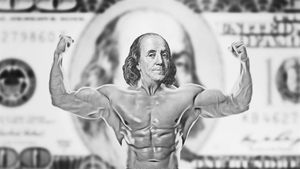
The United States economy delivered a powerful surprise today, September 26, 2025, with the final estimate for Q2 2025 Gross Domestic Product (GDP) growth soaring to an impressive 3.8% on an annualized basis. This figure, significantly higher than earlier estimates, has sent ripples through financial markets, prompting a dramatic reassessment of the Federal Reserve's path forward regarding interest rate cuts. What was once seen as a clear trajectory towards multiple rate reductions this year now appears increasingly uncertain, with a "higher for longer" interest rate environment gaining traction among analysts and investors.
The robust economic expansion indicates a surprising resilience in consumer demand and business activity, challenging the narrative of a slowing economy. This unexpected strength poses a complex dilemma for the Federal Reserve, which must now weigh persistent inflationary pressures against a surprisingly vibrant economic backdrop. The immediate fallout has been a recalibration of market expectations, with bond yields climbing and equity markets exhibiting volatility as participants digest the implications for monetary policy.
A Deeper Dive into the Economic Surge and Market Repercussions
The U.S. Bureau of Economic Analysis (BEA) released the third and final estimate for Q2 2025 GDP growth, revealing a robust 3.8% seasonally adjusted annual rate. This was a substantial upward revision from the advance estimate of 3.0% and the second estimate of 3.3%, marking the strongest quarterly performance since Q3 2023. The primary drivers behind this impressive surge included a notable decline in imports, which contributed positively to the GDP calculation, and a significant acceleration in consumer spending, which expanded at a 2.5% pace—considerably higher than the initial 1.6% projection. This strong consumer activity underscores the continued purchasing power and confidence within the American household.
The financial markets reacted swiftly and decisively to the news on September 26, 2025. Equity markets displayed a mixed reaction, with the Dow Jones Industrial Average (DJIA) experiencing slight declines as investors recalibrated their outlook for corporate earnings in a potentially higher interest rate environment. Rate-sensitive sectors, in particular, felt the pinch. Technology stocks, which often rely on lower borrowing costs for growth and have higher valuations sensitive to discount rates, underwent notable adjustments. In the bond markets, Treasury yields surged across the curve, with the benchmark 10-year Treasury yield climbing approximately 15 basis points in the days following the announcement, reflecting a clear adjustment in expectations for future monetary policy. Concurrently, the U.S. dollar strengthened against most major currency pairs, bolstered by both the relative economic outperformance and the anticipation of sustained interest rate differentials. Perhaps the most significant shift was in rate cut expectations: where investors had previously priced in as many as six quarter-point reductions in 2025, those expectations have now moderated significantly, with forecasts settling around three or four cuts at most, and a growing probability of even fewer adjustments if economic momentum persists.
Companies on the Front Line: Winners and Losers
The unexpected strength in Q2 GDP growth and the subsequent recalibration of interest rate expectations will undoubtedly create a distinct divide between corporate winners and losers in the coming months. Companies operating in cyclical sectors, which are highly sensitive to the economic cycle, stand to benefit from the sustained economic activity. Industrials like General Electric (NYSE: GE) and Caterpillar (NYSE: CAT), along with materials companies such as Dow Inc. (NYSE: DOW) and Freeport-McMoRan (NYSE: FCX), could see increased demand for their products and services as businesses invest and consumer spending remains robust. Financial institutions, including major banks like JPMorgan Chase (NYSE: JPM) and Bank of America (NYSE: BAC), may also initially benefit from a higher-for-longer interest rate environment, as their net interest margins could expand. However, this benefit could be tempered by a potential slowdown in loan origination if higher borrowing costs deter businesses and consumers from taking on new debt.
Conversely, sectors highly sensitive to interest rates are likely to face headwinds. The real estate sector, including homebuilders like D.R. Horton (NYSE: DHI) and Lennar (NYSE: LEN), along with Real Estate Investment Trusts (REITs) such as Simon Property Group (NYSE: SPG), could experience reduced demand as mortgage rates remain elevated, impacting affordability and transaction volumes. Utilities, often seen as bond proxies due to their stable dividends, may also become less attractive compared to rising bond yields. Growth-oriented technology companies, especially those with significant debt or relying heavily on cheap capital for expansion, like some emerging software firms or biotechnology companies, could see their valuations come under pressure as the cost of capital increases and future earnings are discounted more heavily. Companies with substantial refinancing needs in the near term will also face higher borrowing costs, potentially impacting their profitability and investment plans.
Wider Significance: A Resilient Economy and the Fed's Tightrope Walk
This robust Q2 GDP growth signals a remarkable resilience within the U.S. economy, fitting into a broader trend of stronger-than-expected economic performance that has consistently surprised analysts throughout 2024 and into 2025. The implication is clear: the economy possesses underlying strength that can withstand higher interest rates for longer than many had anticipated. This scenario has significant ripple effects. Globally, a stronger U.S. dollar, driven by higher domestic interest rates, can make U.S. exports more expensive and increase the cost of servicing dollar-denominated debt for emerging markets, potentially creating financial stress abroad. Domestically, increased borrowing costs will permeate various sectors, impacting corporate bond issuance, municipal financing, and consumer lending rates, leading to a significant decline in refinancing activity for both businesses and homeowners.
The regulatory and policy implications for the Federal Reserve are profound. The central bank finds itself walking a tightrope, attempting to balance its dual mandate of achieving maximum employment and stable prices. With solid employment figures and now unexpectedly strong growth, the focus may shift more acutely towards controlling inflation, even if it means delaying anticipated rate cuts. Policymakers will be scrutinizing both headline and core Personal Consumption Expenditures (PCE) inflation data for any signs of persistent price pressures, as robust consumer spending inherently raises concerns about ongoing demand-pull inflation. Historically, periods of strong economic growth coupled with elevated inflation have often necessitated a more hawkish stance from the Fed, sometimes leading to a "pause" or even further tightening before any easing can occur. The current situation bears some resemblance to periods in the late 1990s or early 2000s where economic strength allowed the Fed to maintain a less accommodative stance for an extended duration. The yield curve, which has been inverted for an extended period, is now showing signs of normalizing, with short-term and long-term rates adjusting to reflect these changing economic realities and expectations.
What Comes Next: Navigating the New Economic Landscape
In the short term, markets can expect continued volatility as investors and analysts digest the full implications of the stronger-than-expected GDP report. The immediate focus will turn to upcoming inflation data, particularly the monthly PCE reports, and any forward guidance from Federal Reserve officials in their speeches and minutes from future Federal Open Market Committee (FOMC) meetings. Any signs of persistent inflation, especially in core services, will further cement the "higher for longer" narrative. Companies will need to adapt strategically, with those reliant on debt financing potentially pivoting towards more equity-based funding or focusing on cash flow generation to mitigate higher interest expenses.
Looking further ahead, the long-term possibilities include a sustained period of economic growth, but one characterized by a higher cost of capital. This environment could favor companies with strong balance sheets, robust free cash flow, and less reliance on external financing. Market opportunities may emerge in value stocks and sectors that are less sensitive to interest rate fluctuations, such as healthcare or consumer staples, as well as companies that can effectively pass on increased costs to consumers. However, challenges will persist for highly leveraged companies and sectors that thrived on historically low interest rates. Potential scenarios range from a "soft landing" where inflation gradually subsides without a significant economic downturn, albeit with delayed rate cuts, to a more challenging environment if inflation proves stickier and forces the Fed to maintain restrictive policy for an even longer duration, potentially leading to a growth slowdown in late 2025 or early 2026.
Wrap-Up: A Resilient Economy and the Fed's Enduring Challenge
The higher-than-expected U.S. Q2 GDP growth of 3.8% is a testament to the surprising resilience and underlying strength of the American economy. This robust performance, driven by strong consumer spending and declining imports, has fundamentally reshaped the outlook for Federal Reserve interest rate policy, pushing back expectations for significant rate cuts in 2025. The key takeaway is that the economy is proving more durable than anticipated, presenting the Fed with the enduring challenge of managing inflation in a growth-rich environment.
Moving forward, the market will operate under the assumption of a "higher for longer" interest rate regime, at least for the foreseeable future. This necessitates a careful assessment by investors of corporate balance sheets, debt loads, and sensitivity to interest rate changes. The significance of this event lies in its potential to prolong a period of elevated borrowing costs, impacting investment decisions, consumer behavior, and ultimately, corporate profitability across various sectors. Investors should closely watch upcoming inflation reports, particularly the PCE deflator, along with any communications from Federal Reserve officials for clues regarding the future trajectory of monetary policy. Corporate earnings reports will also be crucial in assessing how companies are navigating the current economic landscape and higher cost of capital in the coming months.
This content is intended for informational purposes only and is not financial advice







